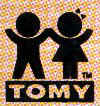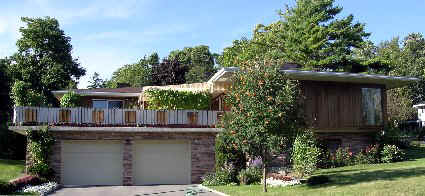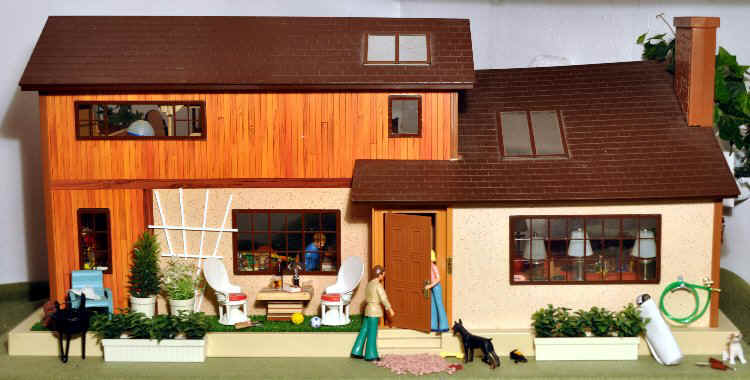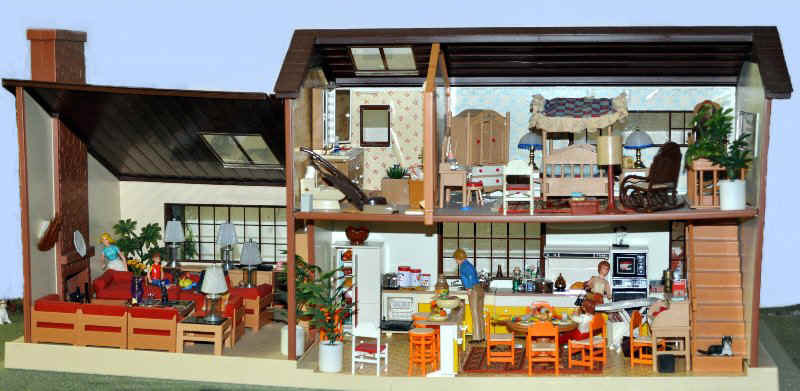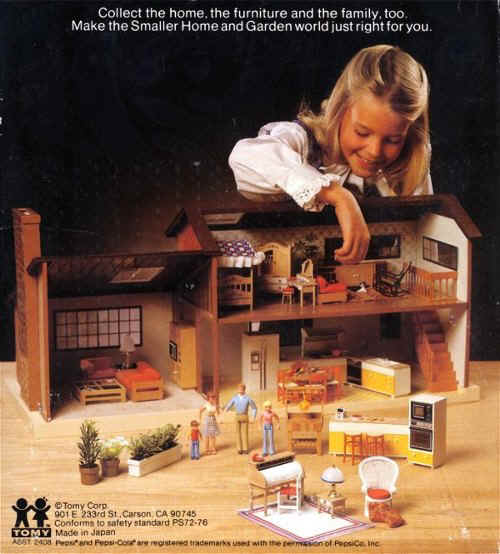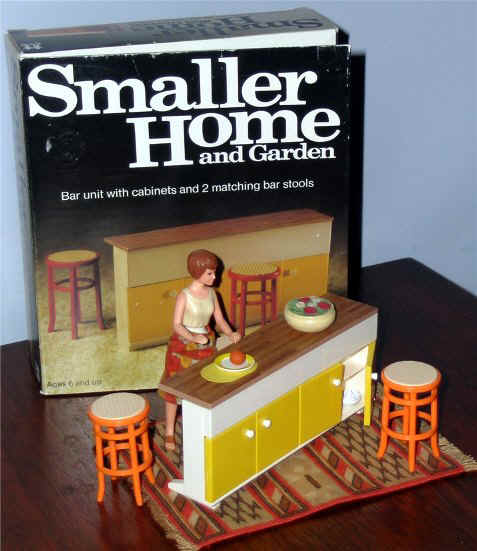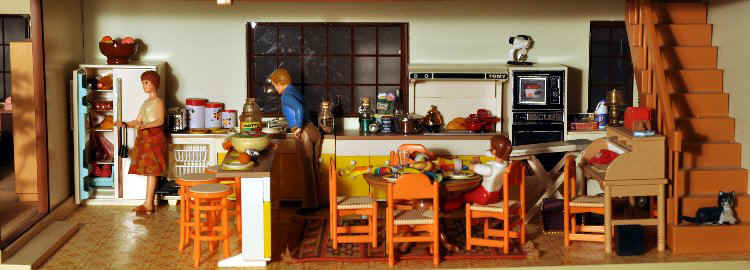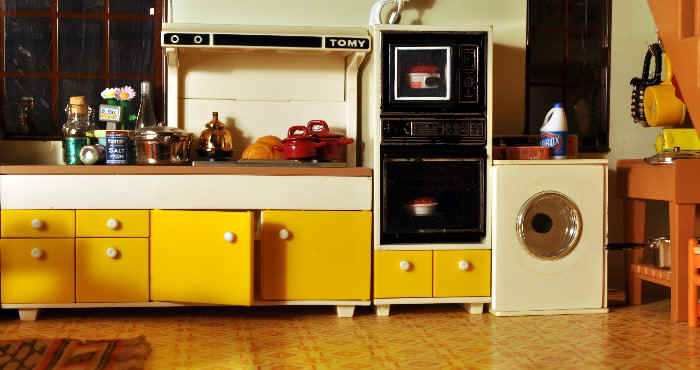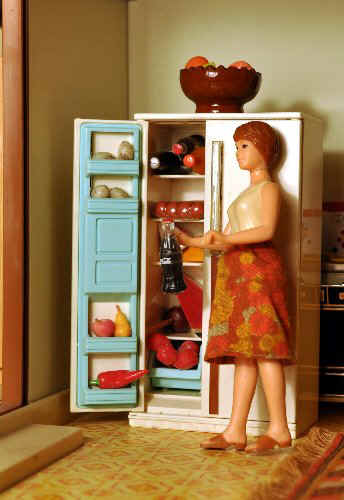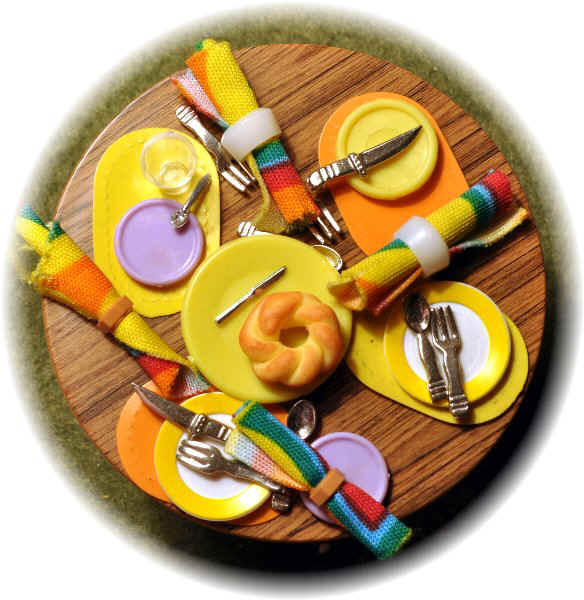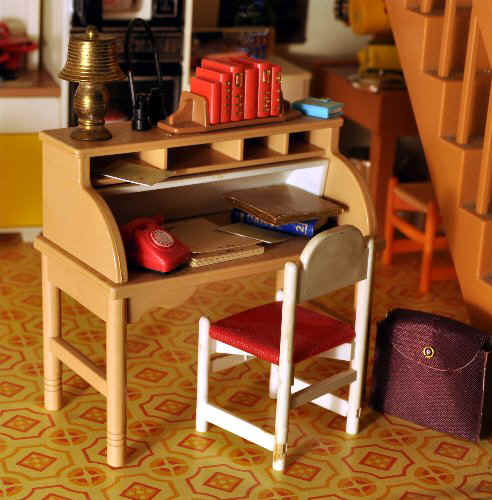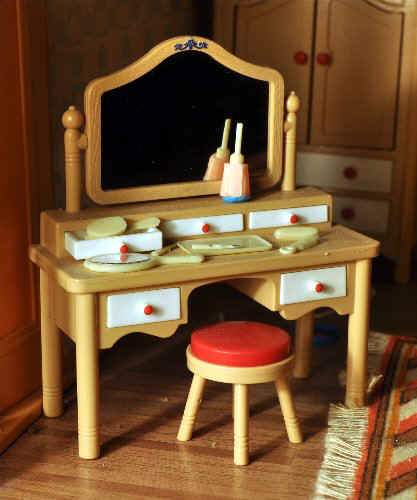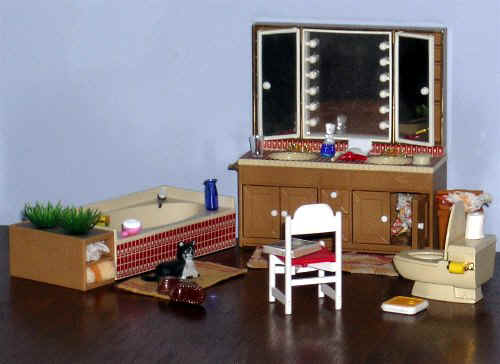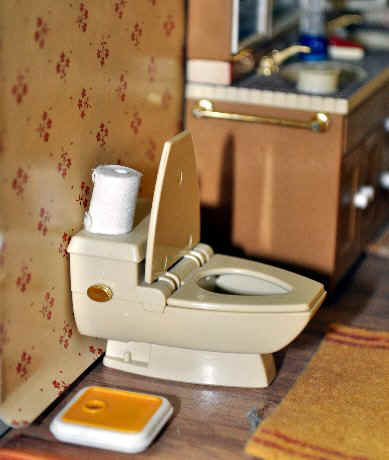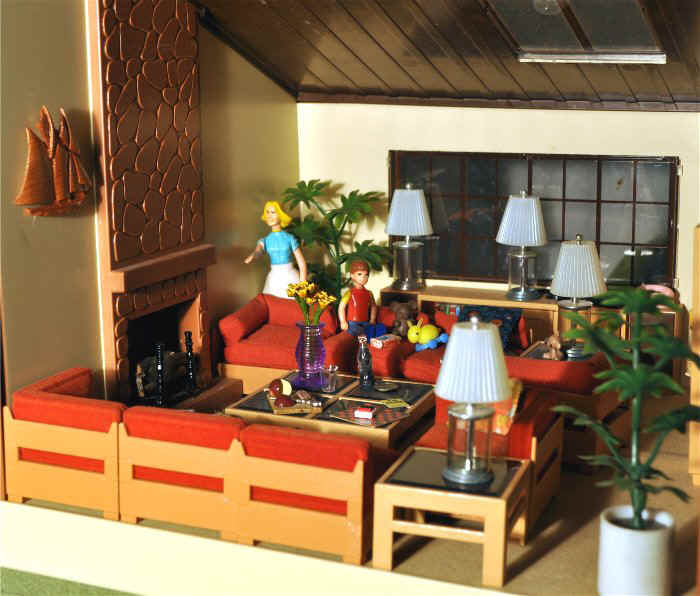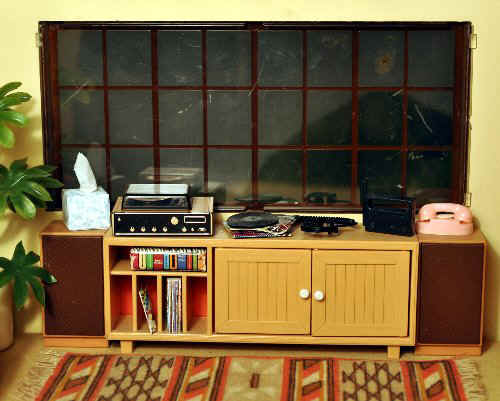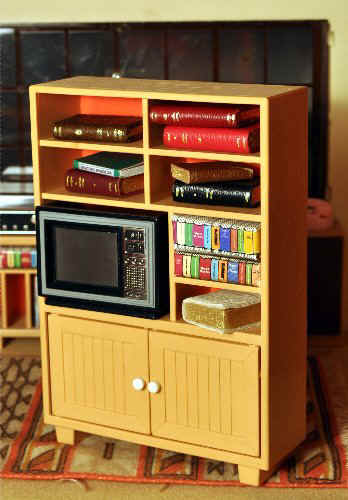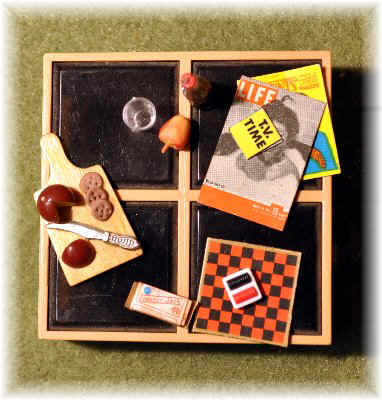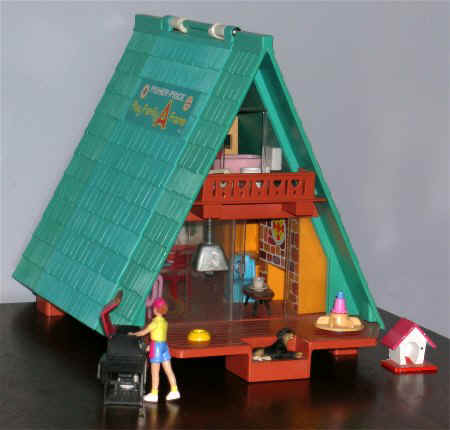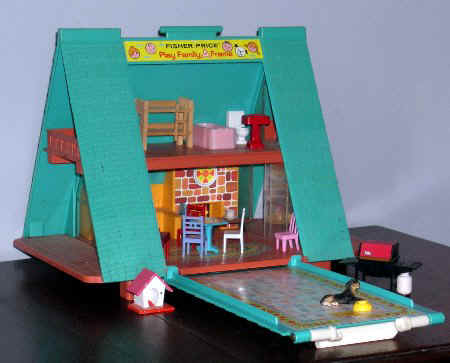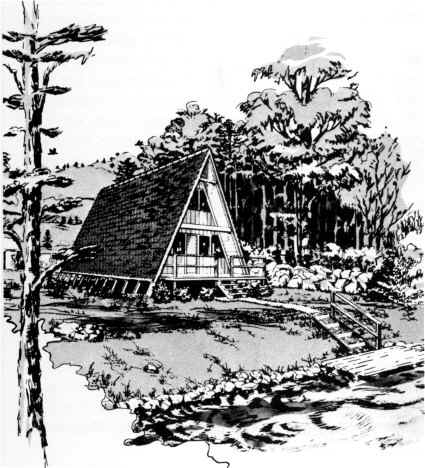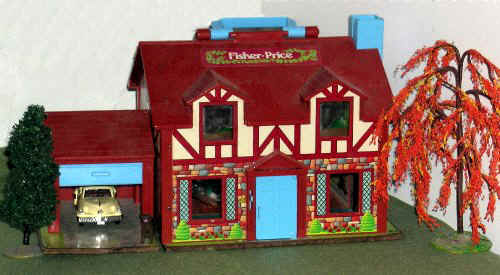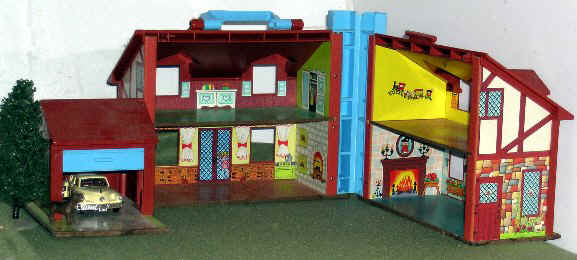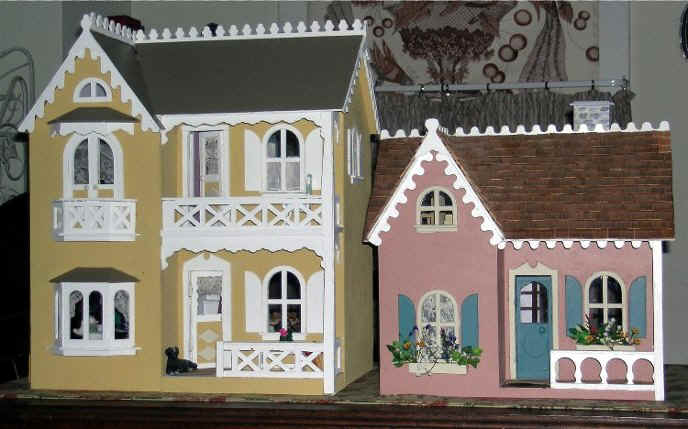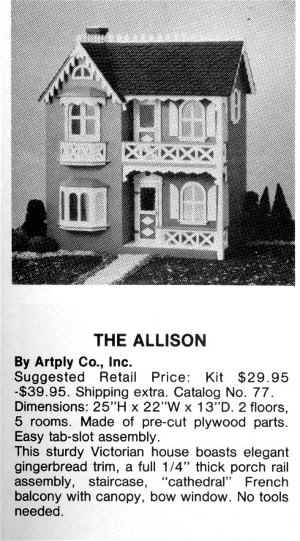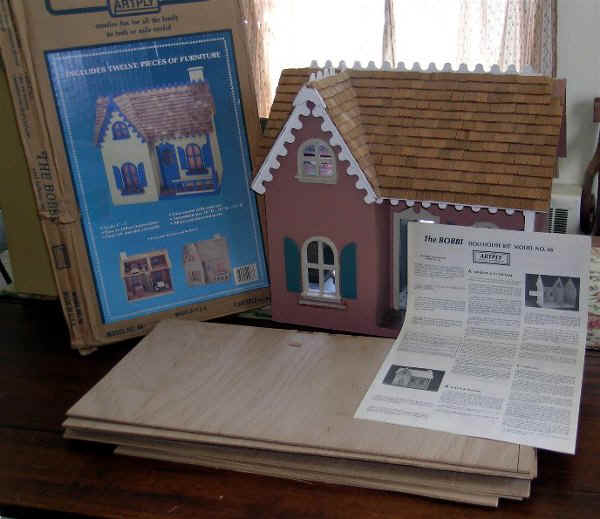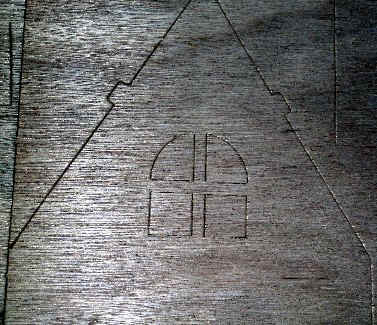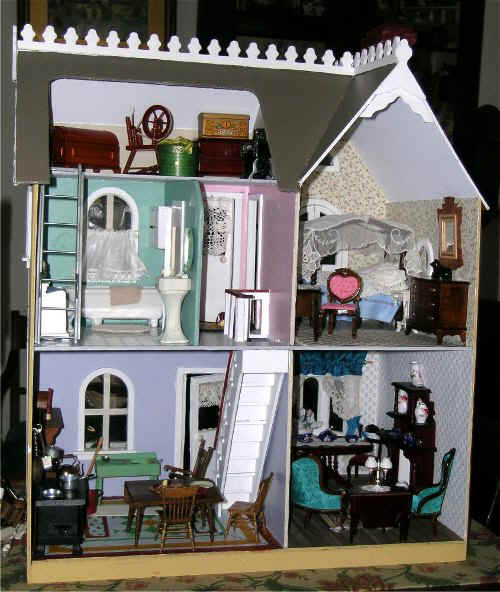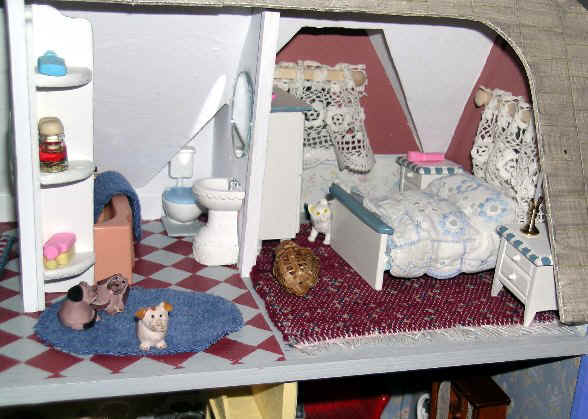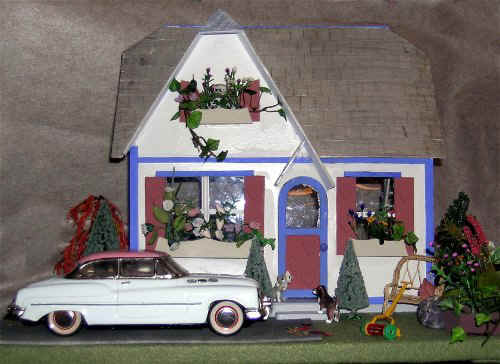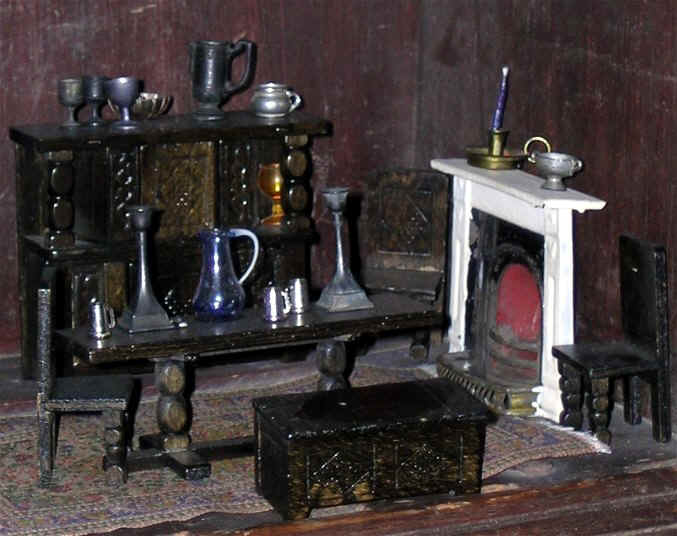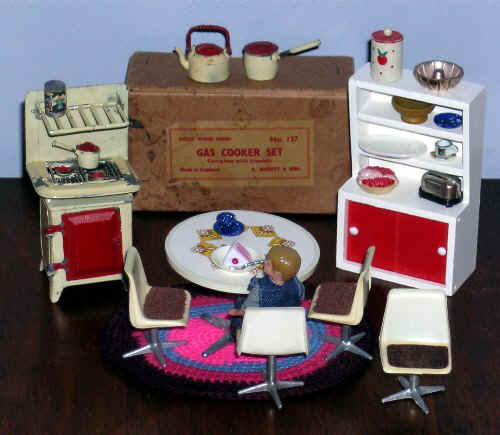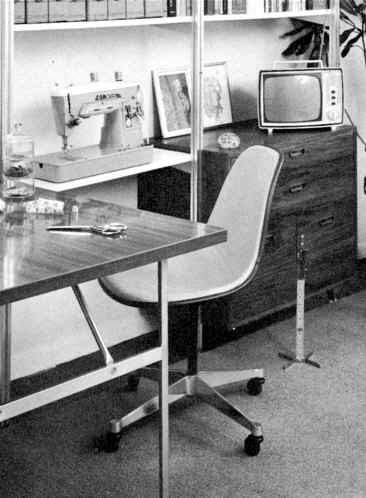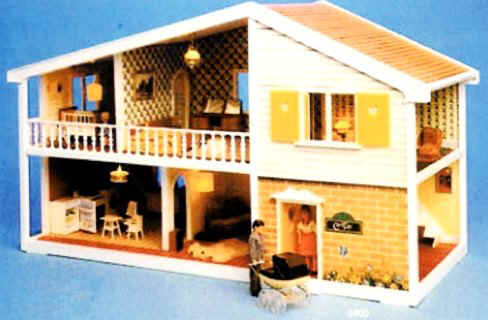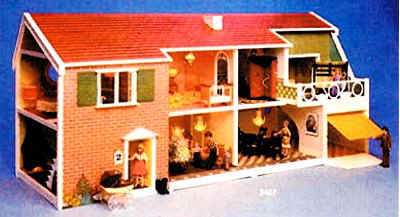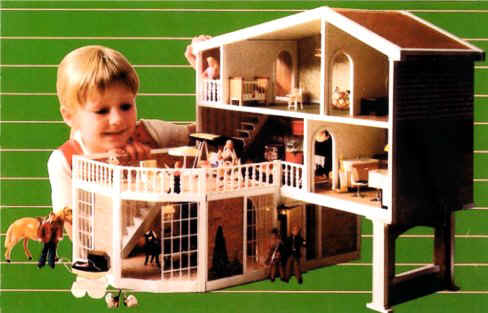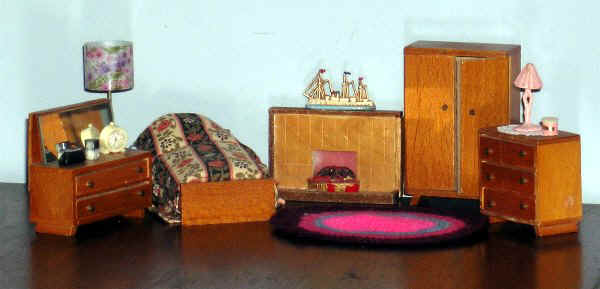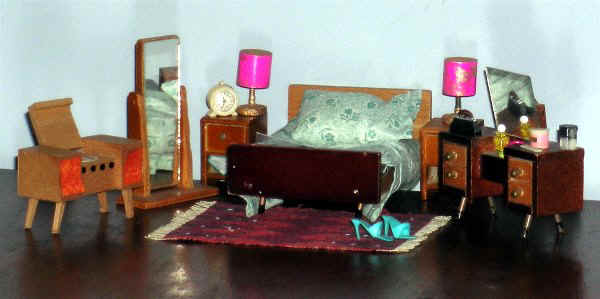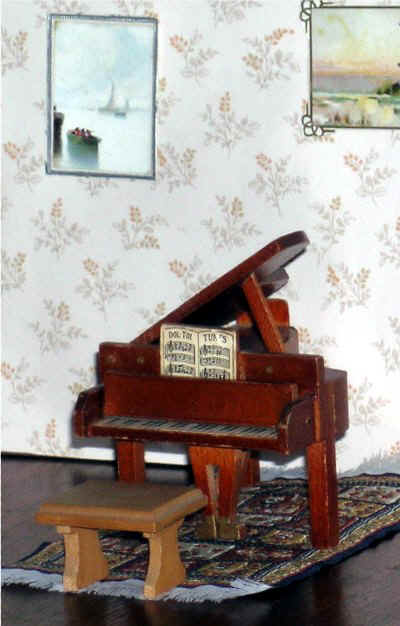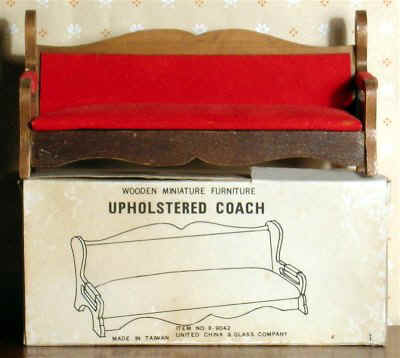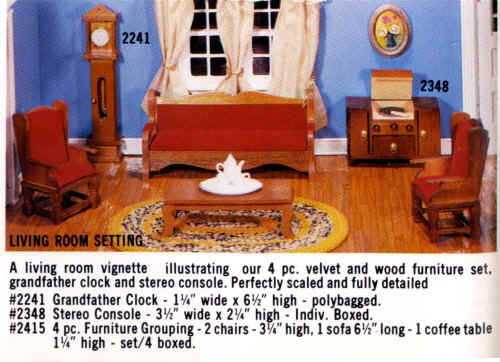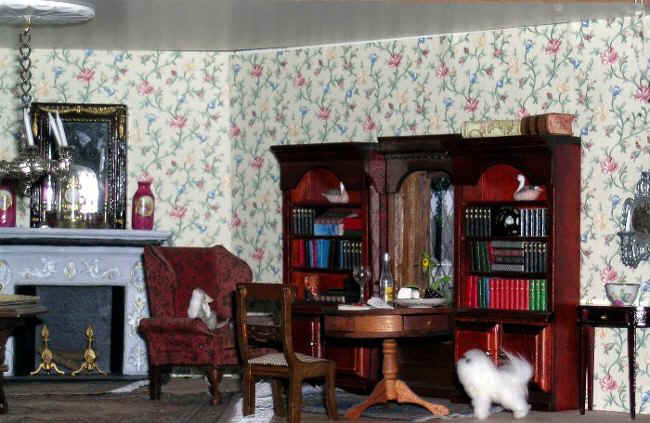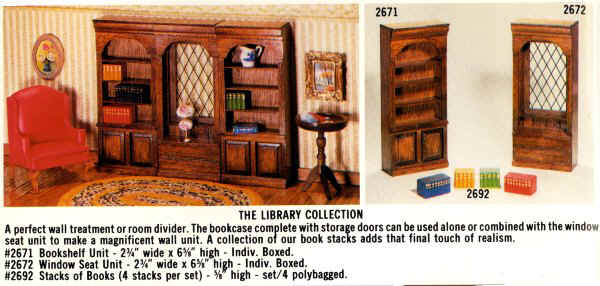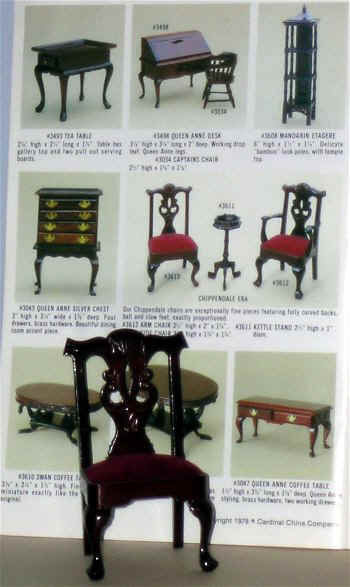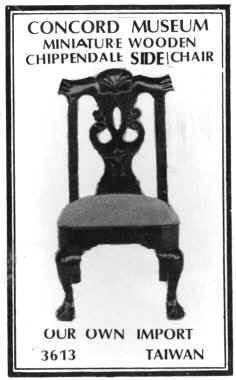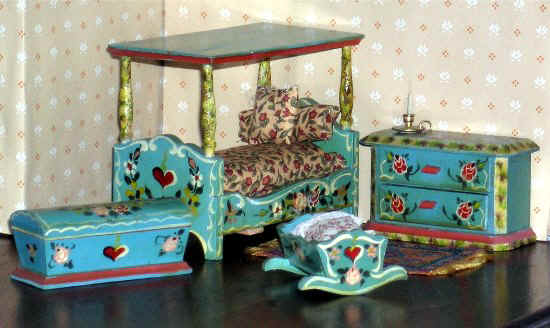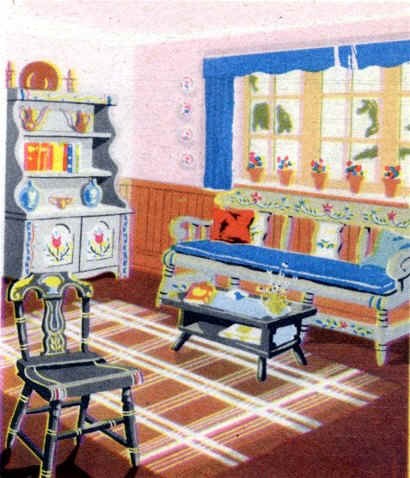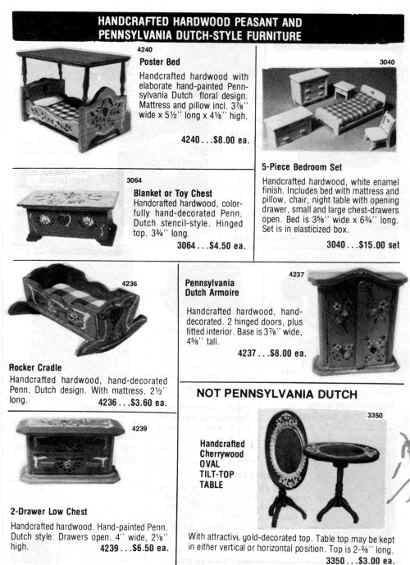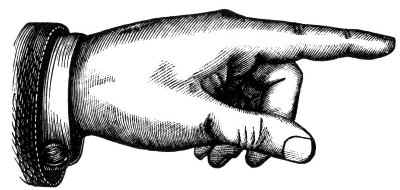|
part 2: 1960-1990 İ |
|
home page 1890s 1900-1920 part 2: 1920s part 2: late 1920s part 1: 1930s part 2: 1930s 1940s 1950s part 1: 1960-1990
all photo: J. McKendryİ
all photo: J. McKendryİ
Despite all the modern aspects of the house and most furnishings,the bed is a traditional four-poster with arched canopy!
all photo: J. McKendryİ The Great Room with its high sloped ceiling and skylight was dominated by an exposed stone fireplace. Sectional couches, glass topped coffee and occasional tables, stereo, earphones, bookcase and television created a setting for comfortable casual living in the late 20th century.
What says modern life more than a coffee table? Especially a smoked glass one.
Fisher-Price's Play Family A Frame (10 inches high) of 1974 was on the same small scale as their Tudor house of 1984 and, although in plastic, are part of a long tradition of printed interiors, with 3-dimensional parts incorporated in the A frame. Its balconies and "glass" sliding doors are attractive. The prominence of the company name, use of a large handle on the roof ridge and the intrusive way it opens act as barriers to visualizing it as a working house. Tudor, of course, is old hat but the A frame is in keeping with contemporary designs, as seen in this illustration of a vacation home of the 1970s by the US Department of Agriculture. The people inhabiting the toy A frame were very stylized and meant for a child's grasp. all photo: J. McKendryİ
To return to our theme about this being the era when children and adult collectors were re-constructing historical dollhouses and furnishings, another avenue (still popular today) was the kit. It is important to consider whether a house you are contemplating purchasing as antique is in fact made from a factory kit in recent years. Once the house is assembled and painted -- and the decor will vary from house to house as the owner's individual taste dictates -- its origins are not always apparent, especially if the house has been roughly played with or left outdoors for a period of time. Appearing older because of harsh handling instead of showing a patina acquired over 70 to 100 years, it may enter the realm of the fake -- sometimes due to lack of knowledge on the seller's part. Let us say that the house's style is Victorian -- perhaps an L plan, verandahs, bay windows and gingerbread trim -- and said to date from the 1880s. In this case, there should be glass in the windows, solid (not plywood) wood walls, nails and aged paint. If, on the other hand, it is a kit of the 1970s or '80s representing a style of the 1900 era, it will have modern thin plastic in the windows, thin plywood (often mahogany), precise cuts due to factory techniques, recent paint, no nails but instead relying on glue and the occasional tab to hold it together. A seller may say it was hand-made in the 1930s or '40s to explain the plywood but, in that time period, the Victorian style was out of favour and would not have been considered when designing a dollhouse. The Victorian style, however, was greatly admired in the last quarter of the 20th century. A search of the web for vintage and new house kits may turn up the precise name of the product for your dollhouse. There is, of course, nothing wrong with buying an assembled kit; it is just that you want to know what you are getting and how this might affect the price (very costly if a "real" 1880 dollhouse and very reasonable if from an 1980 kit). It is equally difficult to distinguish a piece of furniture made from a kit when looking at a photograph but quite apparent when holding it in your hands. One of the signs is the method in kits of gluing drawer fronts over the carcass of the chest of drawers or desk as opposed to working drawers.
Two houses made from kits by the American company Artply -- the Allison on the left and the Bobbi on the right, both in a Victorian style from the 1880s but made in the 1970s or '80s. Colour choices are decided by the individual owner. In this instance, an extra wall has been added for the bathroom and a ladder to access the attic. Wooden and "tile" flooring can be purchased at shops selling miniatures and cut easily to fit. The furnishings represent the c1900 era but are mostly modern reproductions. all photo: J. McKendryİ The Bobbi (right) with sheets of thin plywood
pre-scored for partitions, openings, doors , trim,
etc. Note the tabs on the gable angles. The house was bought assembled but
with missing parts, which were supplied by buying a matching kit.
Typical
kit parts before assembling
The
Allison all photo: J. McKendryİ
Above Another kit adorned with hearts -- the Dura-Craft Sweetheart. Hand-painted tiles make an interesting floor pattern. Note the thin plywood visible on the edge of the roof cut-out -- a typical device for kits -- to access the attic or upper storey. Shown with a 1952 Buick. all photo: J. McKendryİ
One of the furniture companies participating in this enthusiasm for the antique was Barton, located in England and active from 1945 to 1984. Looking quite ancient but made from 1948 to 1977, their dark stained Tudor furniture is attractive. There was a revived interest in the Tudor style in the mid 19th century and, therefore, it would be an appropriate set to use in a Victorian decor. This set, which has staples and incorporates plywood, likely dates from the 1970s. all photo:
J. McKendryİ Taylor
& Barrett
("T&B") of London, 1920 to 1941 with dollhouse items in
production from the mid 1930s, and then F.G. Taylor & Sons
("F.G.T. & Sons") 1945 to 1980 with plastic replacing metal in
1962. From 1945 to 1982, there was A. Barrett & Sons ("B&S") who added dollhouse items to their toy production
in 1953 at the suggestion of the Barton Company. They made metal
fireplaces and gas stoves or cookers (see photo showing one with its box, kettle and pots and dating from 1953-60) for such British and American
companies as Dol-Toi, Shackman,
Federal Smallwares and Barton (and after 1970 to
only the latter); in the 1960s, the metal stoves incorporated plastic parts
such as the door and shelf rack; production of the gas stoves ceased in 1970,
also a time when no more metal toy parts were made due to switching
entirely to plastic. It is possible that the basic moulds for the metal
stoves date from the mid to late 1930s w right Swivelling moulded plastic chair on a chrome pedestal base; illustrated in 1965, Interior decoration A to Z by B. Pepis. Compare with the Caroline's Home kitchen set (above), which appears in the 1976 and later catalogues.
In 1975 Caroline's Home dollhouse (left in Barton's catalogue likely 1981-84) and furniture began production by Barton's (1945-84). In 1984 this product, taken over by Lundby (Caroline's Home Ltd), continued for another decade; by then the furniture was mostly made in plastic (see table and chairs above).
The Super de Luxe Caroline's Home was made in 1980 for a few years (left in Barton's catalogue likely 1981-84)
The Claremont Chalet was added to the Caroline's Home line in 1981. (below in Barton's catalogue likely 1981-84)
all photo:
J. McKendryİ
Barton's
bedroom set shown in a catalogue of 1966; varnished hardwood with chipboard used in less visible parts.
Dol-Toi bedroom set; note the metal legs on the bed and dressing table
A surprising number of pianos of all makes and materials and spanning a wide range in age have survived. They would make an interesting collection.
all photo: J. McKendryİ
In the 1970s, one of the prolific distributors of dollhouse miniatures suitable for the adult collector was the Shackman Company of New York. Pages from the catalogues of the Federal Smallwares Corp., "distributors of Shackman & other fine imports," reveal the origins of many vintage items available to buy in quantity from various web sources such as eBay. Confusion arises when reproductions are offered as antique -- particularly with accessories such as unmarked oil lamps and pottery. Made in such countries as Japan, Taiwan and Germany ("old world craftsmen" according to the company's catalogue), the extensive use of wood for the furniture contrasts with the dominance of plastic marketed by other companies for use by children. As the catalogue tells us: "Cherrywood, Dearie, not plastic or plywood." Concord (Cardinal China Company, Carteret, New Jersey) was another 1970s distributor of miniatures for adults. Both illustrations below are from their 1978 catalogue and are shown with furnishings mainly acquired as vintage from web sources. The same "Early American" sofa is in the Federal Smallwares catalogue of 1975 for $5.75. In addition to their regular wares, Concord sold a line of well made and detailed Museum Miniatures, "exact reproductions in miniature of authentic American antiques."
all photo: J. McKendryİ 1975
above Library in a room setting made in 2006; the bookshelves and window seat are shown below in the 1978 Concord catalogue; the drumtable and chandelier are in a Federal Smallwares catalogue from the 1970s and the sidechair from a set in their catalogue of 1975; the Bichon Frise and wing-back armchair are artisan made
To compound the confusion about what originates where: above This bedroom set is handsomely painted with hearts and flowers over turquoise painted wood. It is easy to source and date because it is stamped "made in West Germany" (after W.W.II and before the demolition of the Berlin wall). But similar pieces without stamps have assumed by sellers to be antique Americana -- early miniature versions of 19th century Pennsylvania items decorated in the Germanic tradition. In fact this 20th century set, no doubt made by the long established German firm Dora Kuhn, was likely meant to be German, as in Germany, to furnish peasant houses sold in the 1960s by F.A.O. Schwarz of New York. According to the 1975 Federal Smallwares catalogue (below right), it was Pennsylvania Dutch-style (a common misconception that it was the work of Dutch not German settlers in Pennsylvania, likely because of confusion over the translation for "German" namely Deutsche), reinforced by an illustration (below left) of a modern American kitchen in a decorating book (Creative Home Decorating by H. & J. Rockow) of 1946 as a "carefree room decorated in the Pennsylvania Dutch style." all photo: J. McKendryİ Indeed, it's a small world.
1946
1975 ****************
Thank you for visiting. |
|
top of page home page articles on antiques & vintage
article on Lundby dollhouses GALLERY OF IMAGES of dollhouses & furnishings
DOLLS for DOLLHOUSES part 1 LIGHTS for DOLLHOUSES
history of dollhouses & furnishings: early furnishings pre 1890
1890s 1900-1920 part 1: 1920s part 2: late 1920s
|
